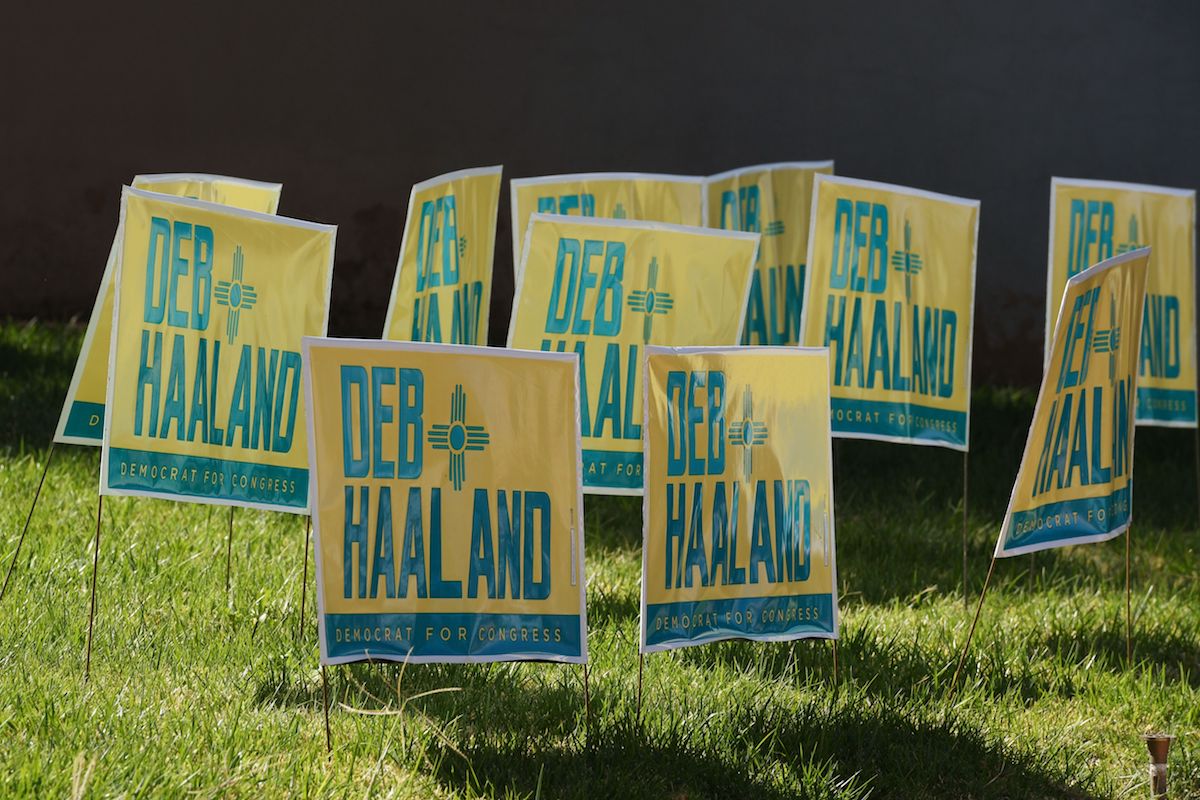

(Photo by MARK RALSTON/AFP/Getty Images)
[Excerpted from The UNM Native American Budget & Policy Institute research brief, posted in full here: The Native American Vote in 2018.]
Introduction
In a historic midterm election that saw minority and women voters energized like never before, one of the major themes was the importance of the Native American population as both voters and candidates. For instance, their vote appears to have swung important races in Montana, Arizona, and New Mexico. This election also resulted in several Native American candidates representing their electoral communities, highlighted by two Native American women headed to Congress: Deb Haaland (Laguna Pueblo) of New Mexico and Sharice Davids (Ho Chunk) of Kansas. Tom Cole (Chickasaw) and Markwayne Mullin (Cherokee), both of Oklahoma, won re-election to Congress. Accentuating the success of Native American statewide candidates, Kevin Stitt (Cherokee) was elected governor of Oklahoma, and Peggy Flanagan (White Earth Ojibwe) was elected as Lieutenant Governor of Minnesota. Forty-eight Native American and Alaska Native candidates won election to state legislative offices.
Although research from our team has found that American Indian and Alaska Natives (AI/ANs) tend to vote at relatively high rates in midterm congressional years, enthusiasm and turnout among Native Americans appeared to be exceptionally high in 2018. A variety of Native American advocacy organizations worked to mobilize Native American voters during the electoral cycle. This includes individual tribal governments and established organizations such as Native Vote and the National Congress of American Indians, and relatively new organizations like Montana Native Vote and #SheRepresents.
These mobilization efforts by organizations and underlying enthusiasm to voice an opinion on President Trump’s policy agenda led Native American community engagement in electoral politics in 2018, as both voters and candidates, at unprecedented levels. This rise in civic engagement occurred in areas where Native American voters were facing tremendous obstacles to participation, including a court ruling upholding the voter ID law in North Dakota that disproportionately burdens Native Americans. Unexpected high turnout rates resulted in several polling locations in Standing Rock having unusually long wait times, with election officials running out of ballots and a need to print more to accommodate voters.
In this blog post which summarizes findings from a more comprehensive brief published by our author team, we provide analysis of the Native American electorate in the 2018 election across multiple dimensions. We analyze the voting behavior of the Native American electorate through the ground-breaking Latino Decisions Election Eve Survey’s national sample of Native American voters. The survey allows us to examine the vote choice, policy attitudes, and views toward the president and both Republican and Democratic parties among 2018 Native American voters.
Findings
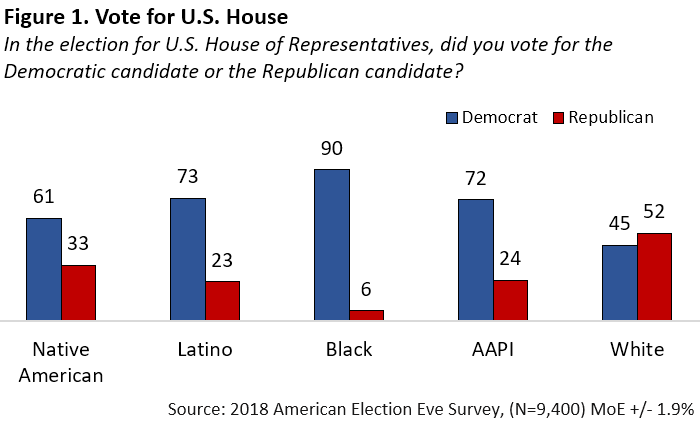

Figure 1 above illustrates 61% of Native American voters cast their ballot for a Democratic Congressional candidate, which is significantly more (15% higher) than the 45% of White voters who voted for Democrats in House races. Native American voters were, therefore, an important contributor to the blue wave that led to the Democratic Party gaining control of the House which included the election of a large slate of Native American candidates.
With the large Native American sample of electorate, we can also explore variation in voting behavior within the diverse Native American community. Below are some of the main sources of variation for Native American voters in 2018:
- There was a significant gender gap with 67% of Native American women reported voting for Democrats compared to 54% of Native American men. This is consistent with the gender gap for other racial and ethnic groups, with women leaning more Democratic in their voting behavior in this election by wide margins across all racial and ethnic groups. Similarly, 72% of Native American women encouraged friends or family to register or vote, a rate 13 percentage points higher than Native American men.
- Cross-over voting among Native American voters benefited Democratic candidates, as 95% of Native American Democrats reported voting for their party’s candidate, compared to 89% of Native American Republicans who report they voted for the GOP candidate.
- Native American Independents broke toward the Democrats, with 46% of independents and other party-identifiers voting for Democrats, 38% voted for Republicans, and 13% for third party candidates.
- Among Native Americans, younger voters (age 18 to 29) were the most politically active age group: 59% had encouraged friends or family to register or vote, 35% attended a protest or demonstration, and 27% volunteered for a candidate or a voter outreach.
Mid-term congressional elections are always a referendum on the president and his party, but this election was uniquely tied to the polarizing agenda and campaign messaging of President Trump. The survey provides several measures of the Native American electorate’s view of President Trump and the Republican Party more broadly. The survey reveals that 58% of Native American voters in the 2018 election disapprove of the job Donald Trump is doing as president, with 45% strongly disapproving.
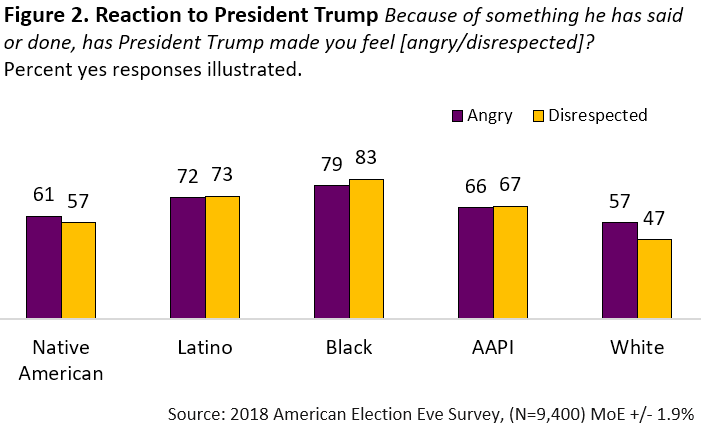

We also found that 61% of Native Americans were angered by something the president has said or done, and 57% felt disrespected. For example, many Native Americans felt outrage over Trump’s lack of respect for the nation-to-nation relationship that shapes interaction between Native nations and the federal government, the lack of respect for Native American cultural sites and lands, and Trump’s use of Native American stereotypes.
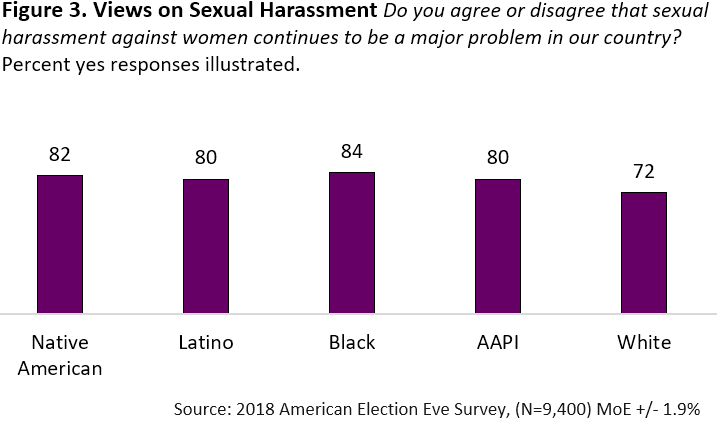

The survey also reveals that 82% of Native American voters believe sexual harassment against women is a major problem in our country. Native Americans lay blame for sexual harassment with the Republican Party, as 68% of Native American voters believe Trump and the Republicans are normalizing sexism and sexual harassment against women.
The strategies of the two parties were clear: Democrats attempted to make the election about health care, and President Trump attempted to make the election a referendum on his approach to immigration. Evidence from the Election Eve Survey indicates that the Democratic strategy had traction, as the policy issue most Native American voters felt that their community politicians should address was health care access and the costs of health care at 32%. This compares to only 10% who reported that border security was the most important issue, trailing not only health care, but also the economy and jobs (28%) and income inequality (14%) among others.
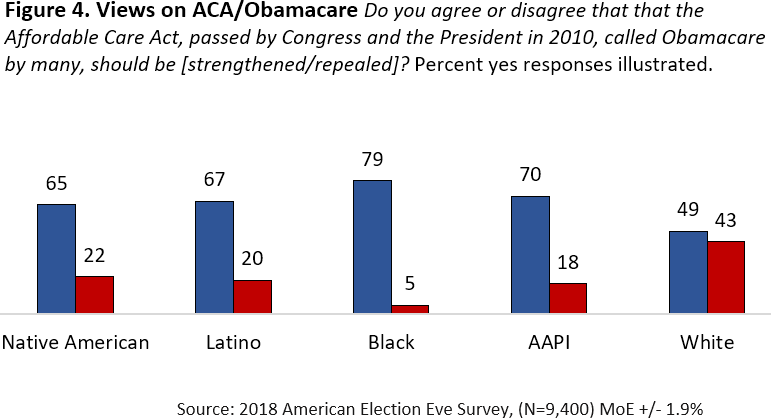

When asked their views on health care, 65% of Native American voters believe Obamacare should be strengthened compared to 22% who believe it should be repealed Attitudes in support of Obamacare are likely due to the significant increase in Native Americans who now report having health insurance under Obamacare, especially Native children. For example, according to a recent Georgetown University study, the uninsured rate for American Indian and Alaska Native adults declined from 36% to 28% and declined for Native American children from 25% to 15% from 2008 to 2015.
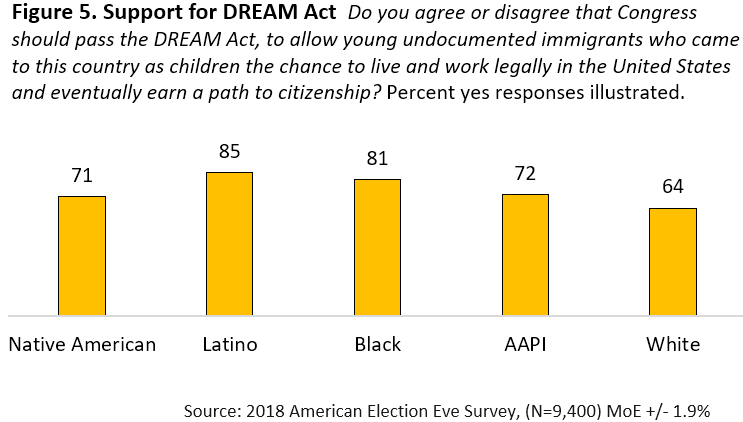

The survey also found that 71%, of Native Americans believe that Congress should pass the DREAM Act. This follows the national trend, where a significant majority of all groups surveyed expressed support for the DREAM Act, as reported in Figure 5 above.
Finally, the American Election Eve survey provides an opportunity to evaluate how Native Americans view the dominant political parties in the country. As reported in Tables 1 and 2, Native Americans are twice as likely as Whites to believe that the Republican Party either doesn’t care too much about their community or is hostile to them—67% compared to 31%.
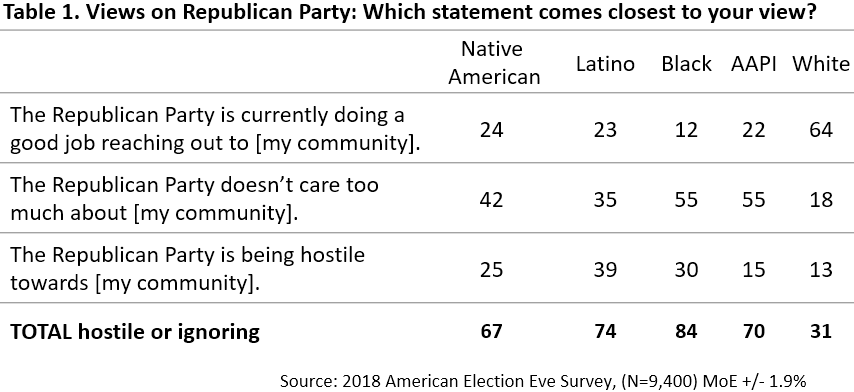

Although it is clear Native American voters do not view the Republican Party as responsive, it is important to note that 48% of Native Americans have similar views about the Democratic Party.
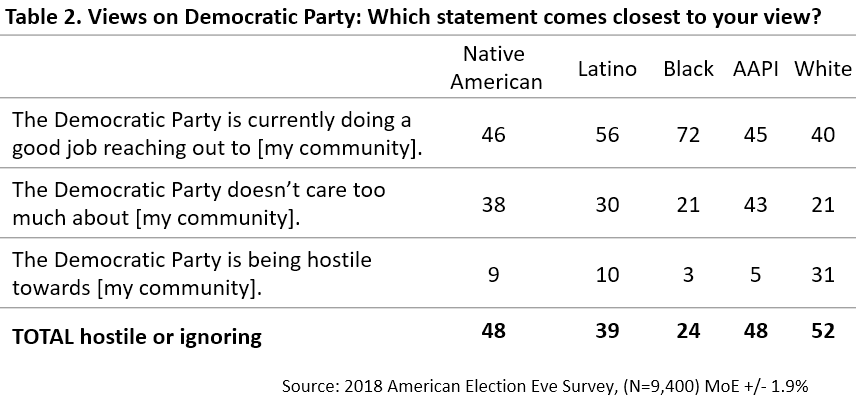

When asked why they voted today, a higher percentage of Native Americans (49%) reported “to support the Native American community,” compared to 19% who reported to “support the Republican Party” and 28% who reported to “support the Democratic Party.” The findings from this survey are consistent with the limited research in this area which suggests that Native American voters are not highly partisan and evaluate candidates based on their view of which would be better for the Native American community (Wilkins and Kiiwetinepinesiik Stark, 2018).
Conclusions and Projections for Native Vote Moving Forward
The Latino Decisions Election Eve Poll and the election results raise a number of implications for Native American politics. First, Native American voters display a commitment to Native American models of political leadership. Sandefur and Deloria (2018) have noted that Native Americans have long valued leaders with community-based political visions and with collaborative approaches that support participation across gender and age. We see parallels in the Election Eve Poll, where Native Americans describe their commitment to the well-being of Native American communities, and Native American women and youth describe their high levels of political engagement.
Second, Native American voters’ highest priority is better health, which puts them at odds with the Trump administration. The Trump administration seeks to cut funding for Native American health care. The Trump administration has resisted measures to address the crisis of missing and murdered indigenous women. If Native American political clout is growing, will it be enough to stop Trump’s plans? Third, representation matters. Many Americans know very little about Native Americans; stereotypes and inaccuracies shape their views of Native people. With more Native American elected officials, other Americans have more chances to observe what Native America is really like.
Fourth, there is reason to hope for better responsiveness to Native American interests. There are now four Native American members of Congress. Other members of Congress relied on Native American voters for victories in competitive elections in 2018. These members include Kyrsten Sinema (D-AZ) and Jon Tester (D-MT) in the Senate and Kendra Horn (D-OK5), Tom O’Halleran (D-AZ1), Collin Peterson (D-MN7), and Xochitl Torres Small (D-NM3) in the House of Representatives. The Election Eve Poll shows that Native American voters want action on health care, economic opportunity, and the treatment of women. Will their elected officials deliver?
A more comprehensive discussion of the Native American Vote in 2018 is below:
***
Laura E. Evans is an associate professor in the Evans School of Public Policy and Governance at the University of Washington.
Raymond Foxworth (Navajo Nation) is vice-president of First Nations Development Institute (First Nations), a Native-led 501(c)(3) nonprofit organization, working to strengthen American Indian economies through investing in and creating innovative institutions and models that strengthen asset control and support economic development for American Indian people and their communities. For more information, visit www.firstnations.org.
Kimberly R. Huyser is an associate professor of sociology and is senior research personnel at the Native American Budget and Policy Institute at the University of New Mexico. Dr. Huyser’s research focuses on the sociology and demography of Native American peoples. Her work is dedicated to deepening our understanding of the lives and opportunities of Indigenous peoples.
Yoshira Macias-Mejia is a PhD candidate in political science at the University of New Mexico and a Robert Wood Johnson Foundation Doctoral Fellow.
Gabriel R. Sanchez is a professor of political science at the University of New Mexico, director of the UNM Center for Social Policy, co-founder of the UNM Native American Budget and Policy Institute, and a principal at Latino Decisions. Sanchez co-wrote an expert witness report for both North Dakota Photo ID cases focused on the impact on Native American eligible voters.


